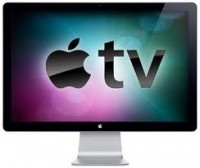The common scenario for the rumored Apple HDTV (the “iTV”) is pretty much a traditional television set with (depending on which reports you believe): Siri voice control; gesture control; 3D (perhaps without glasses); a Retina display for watching 4K movies (such as the upcoming “Hobbit” films); use of an iDevice as a remote control; and a la carte TV programming.
However, if Apple really wanted to think and act different, it could serve up a modular TV or perhaps a glass screen powered by a set-box top.
As reported by “Bloomberg Businessweek” (http://macte.ch/Bc9zj), Israel-based NDS, a TV services provider, thinks that the future of the television is modular. Recently, the company showcased a large matrix of six flat-screen TVs, without bezels, that combined to form a honkin’ big TV wall. The displays could be broken up, airing a video in varying sizes near the middle of the wall, with personalized and content-relevant widgets off to the side. With some cinematic 4K content (such as the aforementioned “Hobbit” films), for example, a viewer may want to use the whole screen, notes “Bloomberg Businessweek.”
NDS used a computer with multiple video outputs to power its six-screen TV wall. This could soon be done using small, mesh networking-capable modules. However, if Apple wanted to jump into the modular TV model now, perhaps it could power the iTV with a Mac.
According to “Bloomberg Businessweek,” NDS Chief Technology Officer Nick Thexton thinks TVs will, in the near future, consist of smaller displays that can be combined to fit a room. Think of 6-in. to 8-in. squares without bezels that you can buy individually, mount on a wall next to one another, and gradually expand the size of the full display to fit your needs.
“A key NDS idea was that huge displays don’t always equal huge videos,” Janko Roettgers writes for “Bloomberg Businessweek.” “Instead of watching your morning news in theater mode, you might watch much smaller clips and use the rest of the screen for other information.”
What’s more, NDS ran its demo using an iPad, allowing users to change the immersion level — and display size — of a video with simple sliders. So imagine this scenario:
An iTV with a basic 30-inch central screen. Screen size could be expanded by adding display modules, which you buy as you need ’em or can afford ’em. All of this is powered by a Mac and run using an iPad or iPhone.
As for Siri and/or gesture control, maybe not. Thexton told “Bloomberg Businessweek” that NDS had evaluated Kinect-like gesture control as well as Siri-like voice control but eventually abandoned both because they seemed to require too much effort and were too prone to errors. In the end, he said, people didn’t want to control their TV in a “Minority Report”-like fashion but with something that feels more natural.
If not a modular iTV, perhaps Apple will sell transparent screens with a glass bezel that you can fix to the wall in every room of your house. “BusinessWeek” columnist Ben Kunz — as reported by Macworld UK (http://macte.ch/92PEa) — thinks we could see screens that hook up to the current Apple TV set-top box (and its descendants) and stream content from your Mac and iTunes. He thinks the screens would use haptic (“touch”) technology (patented by Apple).
“Apple’s real play will be content sales, not TV hardware profits,” Kunz says. “Apple could grab a slice of a $144 billion video market if it could convince us there’s a better way to stream moving images.”
Kunz may be onto something. I especially like the idea of the Mac being an integral part of Apple’s television scenario.
Regardless of whether it’s a modular TV, transparent screens or a more traditional iTV, if Apple can make the ground-making move of offering a la cart TV programming and free us from the cable TV and satellite TV companies, an Apple-branded HDTV will be a success.
— Dennis Sellers

